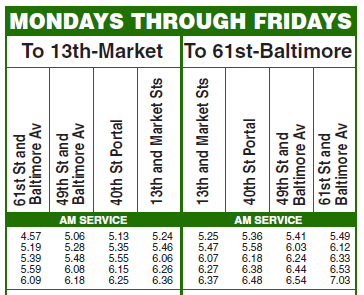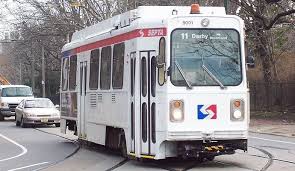Trolley Trips
Submitted By:
In this lesson, students explore an actual trolley route in West Philadelphia and determine the distance and the time it takes to travel between stops. The lesson can be adapted for other bus or trolley routes that stop at every block or at equidistant locations. For adaptations for grades 3-5, see Walk or Ride.
- Map of the neighborhood and trolley route that is to scale (e.g., from Google maps)
- Trolley schedule for Route 11
- Projectable versions of the map and schedule
- List of some familiar locations along the route
- Note that this lesson was written for the Alexander Wilson School at 46th and Woodland Ave. If you are adapting this lesson for a different neighborhood, use a local trolley or bus route and estimate the distance between blocks (You can use Google Maps to calculate)
Ask students if they ever ride the trolley to get places.
Project the Google map of the neighborhood like the one shown below and trace the trolley route along Woodland Avenue. Point out the numbered streets and have students find some familiar landmarks. Ask questions such as:
- If you walk one block, (for example from 49th to 50th), how far do you think that would be? About how long would it take you?
- The blocks along Woodland Avenue are about tenth of a mile. How do we write that? (write as fraction and a decimal).
- How many blocks would you have to walk to walk a mile? (draw a number line on the board to show tenths of a mile and trace a mile or ten blocks on the map). This is a good opportunity to review unit fractions.
- If you started at 46th and Woodland and walked one mile West, where would you be? How do you know?

Tell students that you are going to explore more distances in this neighborhood. Draw a number line and mark the numbered streets along the bottom:
Use the double number line to determine where you would be (street number) if you rode the trolley for 2 miles and 0.5 mile, 1.5 miles. Pick a landmark that they are familiar with from the neighborhood.
- How would you calculate the distance in miles from the 46th St stop to 54th St? (demonstrate on the double number line)
Show the trolley time table and explain how it only shows certain stops on the line.

- Ask students how they can use it to calculate the time it takes for their trip. They should be able to make an estimate from the times on the table. If we wanted to get more exact, could we figure out how long it takes to travel one block?
After several students have shared their ideas, highlight the following steps:
- How many blocks are between the two locations listed on the train schedule? (For example, between 61st and 49th streets, there are 61 – 49 = 12 blocks.) This may be answered by counting blocks on the map or subtraction, but you can write it as a subtraction sentence.
- How many minutes does it take to travel that distance? (Between 5:19 and 5:28, there are 28 – 19 = 9 minutes.) You may want to pick times that do not require reqrouping with time.
- If it takes 9 minutes to travel 12 blocks. How long does it take to travel 1 block? Students may solve this in several ways, using a double number line or a ratio table. ( 9 min for 12 blocks, 4.5 min for 6 blocks, 2.25 min for 3 blocks, 0.75 for 1 block) or by using division to find the unit rate (9 minutes ÷ 12 blocks = ¾ minutes/block or 0.75 minutes/block.) Note that the exact rate will vary based upon the train schedule, the part of the route you are on, and the time of day.
Have student work together to use the number line to find the distances to familiar places, for example:
- Cemegy’s Park (48th and Woodland)
- Foot Locker (60th and Woodland)
- Paschalville Library (69th and Woodland)
- 54th St to 66th St.
Use a trolley schedule to have students plan a trip somewhere. Calculate the time on the trolley as well as walking distance, using the rate of 2 minutes per block.
Have students share strategies they used for finding these distances. Some students might use addition, while others might use multiplication. Record their solutions as number sentences so that they see the connection to the operations.
Some questions you can ask to focus on the mathematics include:
- Is there a more efficient way to determine the total distance walked than repeatedly adding 0.1 for each block? (0.1 + 0.1 + 0.1)
- How could you calculate the total distance walked if you went 58 blocks? What would that look like as a fraction? As a decimal?
- How could you calculate the total distance if you went X blocks?
- Have students look at different transit schedules and see if there are parts of the route where you travel faster or slower. For example, the 34 trolley takes only 11 minutes to travel from 40th and Market to 13th and Market where the trolley goes underground, a rate of 11 minutes ÷ 27 blocks = 0.41 minutes per mile. Give students compound problems where they must combine two travel times for two different parts of the city. For example, find locations on the map that would require them to travel 9 blocks at 0.75 minutes per block and then 12 more blocks at 0.41 minutes per block. Have students show how they used a combination of adding and multiplication to find the total time.

 Septa Trolley Maps
Septa Trolley Maps Trolley Trips Student Handout
Trolley Trips Student Handout


Comments
(no comments)